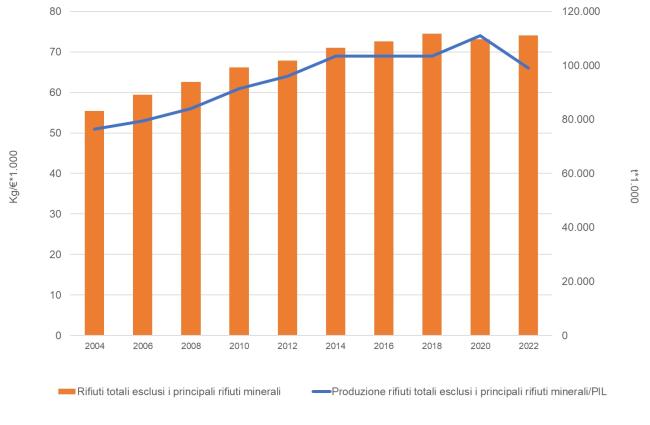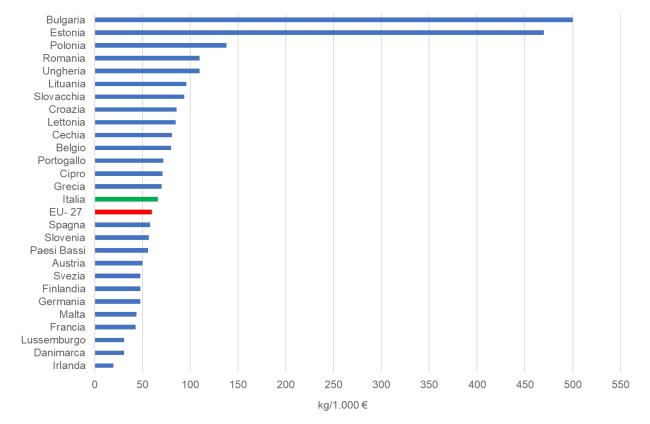Panel 1
Simona Buscemi, Cristina Frizza, Costanza Mariotta, Jessica Tuscano
The indicator evaluates the pressures on the environment and the efficiency of resources used by the economy to generate wealth, as well as its progress toward achieving a circular economy. In 2022, the ratio of national waste production to gross domestic product (GDP) was slightly above the European average (66 kg/1,000€ vs. 60 kg/1,000€). Overall, the economic system still appears unable to limit waste production in relation to the wealth produced.
The indicator measures the total amount of hazardous and non-hazardous waste produced by economic activities and households, excluding major mineral waste from the construction and demolition sector. This exclusion is due to the significant impact of this type of waste on total production. By normalizing the ratio, a more meaningful comparison can be made, even between countries with significant mining and construction sectors. The economic efficiency of waste production is also calculated by relating it to GDP.
To monitor progress toward a circular economy in the thematic area of "production and consumption."
Directive 2008/98/EC; Legislative Decree No. 152/2006 and subsequent amendments
Ministerial Decree, October 7, 2013 - Adoption and approval of the National Waste Prevention Program (Official Gazette, October 18, 2013, No. 245)
The European Directive establishes measures to protect the environment and human health by preventing or reducing waste production, minimizing the negative impacts of waste production and management, reducing the overall impacts of resource use, and improving their effectiveness and efficiency. These are fundamental elements for the transition to a circular economy and ensuring the long-term competitiveness of the European Union.
Panel 2
ISPRA - Rapporto rifiuti urbani, Editions 2021-2023;
ISPRA - Rapporto rifiuti speciali, Editions 2022-2024
Data quality assessment
EUROSTAT (Statistical Office of the European Communities)
ISPRA (Higher Institute for Environmental Protection and Research)
ISTAT (National Institute of Statistics)
The data are based on information collected through the annual Environmental Declaration Forms (MUD), submitted by entities subject to mandatory reporting under current legislation. These are supplemented with quantitative estimates produced by ISPRA, which are not publicly accessible.
Data on the generation of special waste—both hazardous and non-hazardous—disaggregated by region, economic activity, and chapter of the European Waste Catalogue (EWC), can be accessed through the Waste Cadastre website at: www.catasto-rifiuti.isprambiente.it.
Gross Domestic Product (GDP) data are available on the website of the Italian National Institute of Statistics (ISTAT): https://esploradati.istat.it/databrowser/#/.
For European-level comparisons, data can be found on the Eurostat website at: https://ec.europa.eu/eurostat/.
National
2004-2022
Indicator assessment
The indicator measures the amount of hazardous and non-hazardous waste from all economic sectors and households, including those from waste treatment. Major mineral wastes are excluded, as defined by Regulation 2150/2002/EC on waste statistics, including:
-
Construction and demolition mineral waste (cement, brick, gypsum, road surfacing materials containing hydrocarbons, mixed construction waste)
-
Other mineral waste (asbestos, natural mineral waste, artificial mineral residues, refractory material residues)
-
Earth
-
Dredged earth The total waste quantity, excluding major mineral waste, is also compared to GDP (chain-linked values, reference year 2010).
After a significant drop in total waste production in 2020 (from 111.8 million tons in 2018 to 109.7 million tons), production increased again in 2022, reaching 111.1 million tons (+1.3%, Table 1 and Figure 1).
For every euro of GDP, 66 tons of waste were produced, a lower value than recorded in 2020 (74 tons per euro of GDP), returning to pre-pandemic levels. At the European level, Italy ranks among countries with a waste-to-GDP ratio (66 kg/€*1,000) higher than the EU average (60 kg/€*1,000), indicating a poor status (Figure 2).
The amount of total waste produced shows a gradual increase over the years, except for the decline in 2020, which was due to the COVID-19 health emergency that affected the national socioeconomic context (Table 1 and Figure 1). In 2022, production increased again, showing a 33.7% rise compared to 2004. The amount of total waste produced relative to GDP also grew during this period, but at a lower rate (+29.4%). In 2022, contrary to the previous year, there was a decrease in waste production per unit of GDP (Table 1 and Figure 1). Given that the economic system has not yet managed to limit waste production relative to the wealth produced, the deviation in the last year should be monitored over a longer period to determine if it is part of a real trend reversal.
Data
Table 1: Total waste generation excluding major mineral wastes, relative to GDP.
ISPRA elaborations based on ISPRA and ISTAT data


The national socioeconomic context in 2020 was marked by the COVID-19 health emergency, which affected national consumption and manufacturing production. In 2022, total waste production, both hazardous and non-hazardous, from economic activities and households, returned to pre-pandemic levels, reaching approximately 111.1 million tons, after the decline recorded in 2020. The impact of the COVID-19 health emergency on the Italian economy led to a decrease in both waste production and GDP, but more significantly for the economic indicator, causing an increase in the waste-to-GDP ratio. In 2022, however, this ratio decreased due to a more substantial increase in GDP compared to waste production (Table 1 and Figure 1).